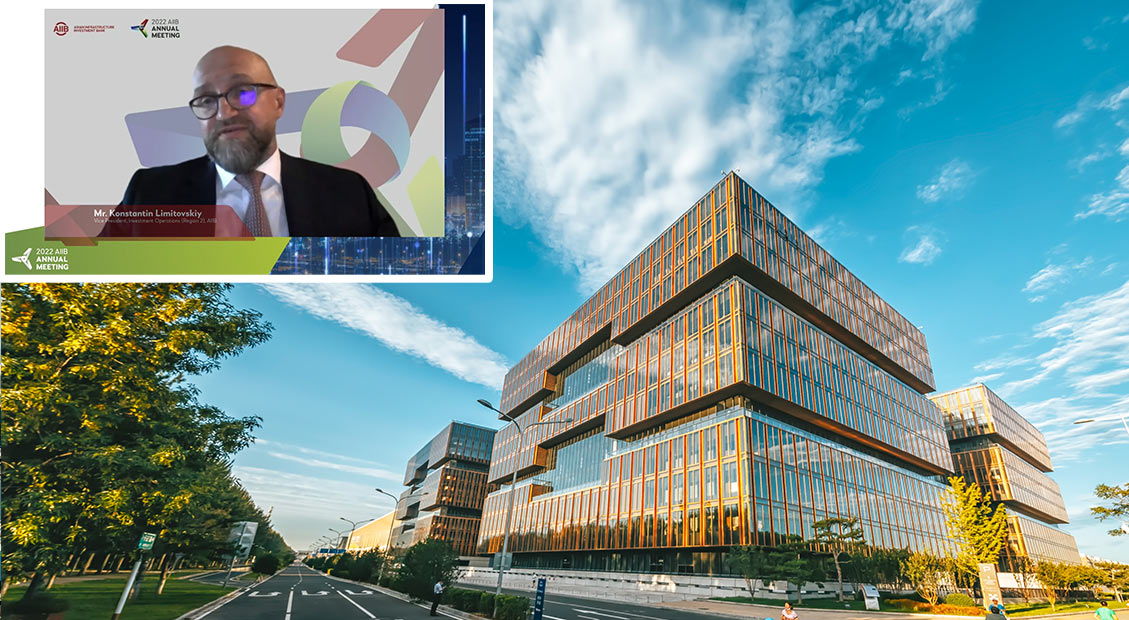“Modern infrastructure is vital for economic development and job creation, and the need for infrastructure finance is going to be even more pronounced and urgent post-pandemic as the world is facing overlapping crises,” said Konstantin Limitovskiy, Vice President, Investment Operations (Region 2), of the Asian Infrastructure Investment Bank (AIIB).
Amid the very real challenges in both the investment and geopolitical world, it may seem counterintuitive to talk about investing in infrastructure at this time.
David Rubenstein, Co-Founder and Co-Chairman of The Carlyle Group, who spoke during the 2022 Annual Meeting of the AIIB Board of Governors in a session titled “Private Capital Mobilization in the Global Infrastructure Market,” said he has two good reasons why we need to focus on enhancing infrastructure projects in Asia and the rest of the world right now.
“One, I think that the business world can show that it is able to overcome political and geopolitical concerns because the need for infrastructure investment is very, very great in Asia,” said Rubenstein. “Second, I think Asia can be the place that shows the rest of the world how to really build 21st century infrastructure.”
He emphasized the need for infrastructure that are responsive to the needs and demands of the changing climate and increasing digitalization.
“We really need transformation-related infrastructure and digital infrastructure,” Rubinstein said. “We have to change the way we build so that the digitization of society can move forward unimpeded.”
Alicia García Herrero, Chief Economist, Asia Pacific, Natixis, believes it can be done, but everything is going to be costlier.
“Asia is a dual reality. It is the only region in the world where half has an aging population and naturally low interest rates,” she said.
These aging economies are, in general, the ones with good infrastructure while the other side of Asia is young and lacks infrastructure. This duality, Herrero said, makes for a “marriage of convenience,” where the parts of Asia that have lower interest rates will use their savings to work with the younger side to enhance their infrastructure.
“Of course, capital still won't be as abundant, so you need to choose your projects and use your marriage of convenience to make it easier to finance infrastructure,” said Herrero.
“The challenge is how do you get the capital to those needs, whether to generate investor interest or select the right assets?” asked Kevin Lu, Partner and Chairman of Asia, Partners Group, a global private markets firm.
The appeal to infrastructure investing is built in, according to Rubenstein. It is profitable, has a lot less risk and there is a good social purpose behind it. It has become an asset class on its own, and the appetite for this type of investment is growing.
“Now virtually every sovereign wealth fund, every public pension fund that I'm aware of, has a distinct category for infrastructure,” Rubenstein said. “People are increasingly wanting to increase their infrastructure allocations.”
With private capitalization for infrastructure development on the rise, governments play a crucial role in boosting its growth, particularly in the region, according to Jose Isidro Camacho, former Secretary of Finance and Energy in the Philippines who is also a member of AIIB’s International Advisory Panel.
“We know that because of the pandemic, many governments are a little bit more stressed as far as fiscal resources are concerned,” said Camacho. “This means governments will have to rely even more on private capital for infrastructure.”
Camacho said governments have several roles to play in mobilizing private sector capital in Asia:
- As regulators to assure private investors that it is safe to invest in their particular economies.
- As legislators to enact laws and regulations that make for a conducive environment for private investments.
- As active promoters of policy to allow governments to gain access to private capital 7for infrastructure development.
- As investors themselves to co-invest with the private sector and demonstrate confidence.
Meanwhile, AIIB Vice President Limitovskiy reiterated that sovereign funding can only meet part of the need for infrastructure development, which is why AIIB is committed to catalyzing private capital to play a fundamental role in financing Infrastructure for Tomorrow or sustainable, climate-resilient infrastructure. Private capital mobilization is one of AIIB’s four key thematic priorities under its corporate strategy. The Bank has set up an ambitious target of growing the share of nonsovereign finance to 50 percent of its overall portfolio by 2030. AIIB has made great progress on this front, approving 70 nonsovereign projects worth USD7.7 billion, 37 percent of the total number of approved projects. AIIB had already mobilized close to USD5 billion of private capital for infrastructure development since 2016, starting with just USD20 million in 2016 to USD1.4 billion by 2021.
One of AIIB’s strategic private sector partners is Bayfront Infrastructure Management, which was established in 2019 as a joint venture between the Clifford Capital Group and AIIB.
“We were set up primarily with the objective of helping to bridge the huge gap in infrastructure in Asia and to create a channel for institutional investors to get into Asia-Pacific infrastructure debt,” said Premod Thomas, Bayfront Chief Executive Officer and Executive Director.
In the midst of global health, economic and geopolitical crises, Thomas said infrastructure needs in the region continue to grow as evidenced by the infrastructure projects being pursued.
“There is a quantum jump that infrastructure developers and governments are engendering through making a lead to sustainability transition, digital infrastructure and all the things required by our rapidly urbanizing set of societies in this part of the world,” he added.
In closing the session, Limitovskiy emphasized: “Private capital mobilization for development in infrastructure is our critical need today and we in AIIB, as a global institution with a sharp focus on Asia, is fully committed to work with the private sector players in leveraging the huge potential of the development financing institutions.”
Watch the session replay on AIIB’s YouTube channel.


